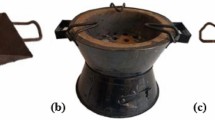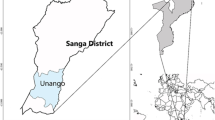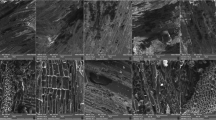Abstract
Firewood and charcoal are the most dominant sources of fuel for domestic cooking applications in sub-Saharan Africa. In this study, performance and emission characteristics of firewood and charcoal from five commonly used species, namely, Dichrostachys cinerea, Morus Lactea, Piliostigma thonningii, Combretum molle, and Albizia grandibracteata were obtained. The water boiling test and emissions monitoring system for CO, CO2, and PM2.5 were used to determine fuel and energy consumption, thermal efficiency and emissions, and emissions’ factors. The results showed that firewood combustion required higher energy consumption compared to charcoal combustion. High-power thermal efficiency was the highest (> 45%) for all charcoal derived from the firewood species. During hot-start, cold-start, and simmering operations, it was observed that thermal efficiencies were generally higher for charcoal fuels (≥ 80%) compared to the firewood (< 40%) from where they were pyrolyzed. Firewood has a much lower indoor CO emissions footprint when compared to using charcoal. Nonetheless, CO emission levels for both firewood and charcoal exceed the Environmental Protection Agency (EPA) guidelines of 35 ppm (1-h average). CO2 emission factors are the most dominant and highest contributors to greenhouse gas emissions from household use of firewood and charcoal. Overall, this work re-affirms the need for proper ventilation when firewood and charcoal are used in combustion.






Similar content being viewed by others
Data availability
Data associated with this research is available upon request to the corresponding author.
References
Bamwesigye D, Kupec P, Chekuimo G, Pavlis J, Asamoah O, Darkwah A, Hlavackova P (2020) Charcoal and wood biomass utilization in Uganda. The socioeconomic and environmental dynamics and implications. Sustainability 12:8337. https://doi.org/10.3390/su12208337
Nzabona A, Tuyiragize R, Asiimwe JB, Kakuba C, Kisaakye P (2021) Urban household energy use: analyzing correlates of charcoal and firewood consumption in Kampala City, Uganda. J Environ Public Health 2021:5904201. https://doi.org/10.1155/2021/5904201
Grimsby LK, Rajabu HM, Treiber MU (2016) Multiple biomass fuels and improved cook stoves from Tanzania assessed with the water boiling test. Sustain Energy Technol Assess 14:63–73. https://doi.org/10.1016/j.seta.2016.01.004
Ezzati M, Mbinda BM, Kammen DM (2000) Comparison of emissions and residential exposure from traditional and improved cookstoves in Kenya. Environ Sci Technol 34:578–583. https://doi.org/10.1021/es9905795
Bhattacharya SC, Albina DO, Abdul SP (2002) Emission factors of wood and charcoal-fired cookstoves. Biomass Bioenerg 23:453–469. https://doi.org/10.1016/S0961-9534(02)00072-7
Jetter JJ, Kariher P (2009) Solid-fuel household cookstoves: characterization of performance and emissions. Biomass Bioenerg 33:294–305. https://doi.org/10.1016/j.biombioe.2008.05.014
Arora P, Das P, Jain S, Kishore VVN (2014) A laboratory based comparative study of Indian biomass cookstove testing protocol and water boiling test. Energy Sustain Dev 21:81–88. https://doi.org/10.1016/j.esd.2014.06.001
Jetter J, Zhao Y, Smith KR, Khan B, Yelverton T, DeCarlo P, Hays MD (2012) Pollutant emissions and energy efficiency under controlled conditions for household biomass cookstoves and implications for metrics useful in setting test standards. Environ Sci Technol 46:10827–10834. https://doi.org/10.1021/es301693f
Obeng GY, Mensah E, Ashiagbor G, Boahen O, Sweeney DJ (2017) Watching the smoke rise up: thermal efficiency, pollutant emissions and global warming impact of three biomass cookstoves in Ghana. Energies 10:641. https://doi.org/10.3390/en10050641
Kaur-Sidhu M, Ravindra K, Mor S, John S (2020) Emission factors and global warming potential of various solid biomass fuel-cook stove combinations. Atmos Pollut Res 11:252–260. https://doi.org/10.1016/j.apr.2019.10.009
Yigezu ZD, Jawo TO (2021) Empirical analysis of fuelwood consumptions and its environmental implications in rural sub-city, Southern Ethiopia. Int J Sustain Energ 40:448–458. https://doi.org/10.1080/14786451.2020.1812609
Bailis R, Ezzati M, Kammen DM (2003) Greenhouse gas implications of household energy technology in Kenya. Environ Sci Technol 37:2051–2059. https://doi.org/10.1021/es026058q
Bailis R, Ezzati M, Kammen DM (2005) The role of technology management in the dynamics of greenhouse gas emissions from household energy use in sub-Saharan Africa. J Environ Dev 14:149–174. https://doi.org/10.1177/1070496504273651
Mwampamba TH, Ghilardi A, Sander K, Chaix KJ (2013) Dispelling common misconceptions to improve attitudes and policy outlook on charcoal in developing countries. Energy Sustain Dev 17:75–85. https://doi.org/10.1016/j.esd.2013.01.001
Roden CA, Bond TC, Conway S, Pinel ABO (2006) Emission factors and real-time optical properties of particles emitted from traditional wood burning cookstoves. Environ Sci Technol 40:6750–6757. https://doi.org/10.1021/es052080i
Downward GS, van der Zwaag HP, Simons L, Meliefste K, Tefera Y, Carreon JR, Vermeulen R, Smit LA (2018) Occupational exposure to indoor air pollution among bakery workers in Ethiopia; a comparison of electric and biomass cookstoves. Environ Pollut 233:690–697. https://doi.org/10.1016/j.envpol.2017.10.094
Lin C, Huang RJ, Ceburnis D, Buckley P, Preissler J, Wenger J, Rinaldi M, Facchini MC, O’Dowd C, Ovadnevaite J (2018) Extreme air pollution from residential solid fuel burning. Nature Sustainability 1(9):512–517. https://doi.org/10.1038/s41893-018-0125-x
Lea-Langton AR, Spracklen DV, Arnold SR, Conibear LA, Chan J, Mitchell EJS, Jones JM, Williams A (2019) PAH emissions from and African cookstove. J Energy Inst 92:587–593. https://doi.org/10.1016/j.joei.2018.03.014
Guo M, Song W, Buhain J (2015) Bioenergy and biofuels: history, status, and perspective. Renew Sustain Energy Rev 42:712–725. https://doi.org/10.1016/j.rser.2014.10.013
Nabukalu C, Giere R (2019) Charcoal as an energy resource: global trade, production and socioeconomic practices observed in Uganda. Resources 8:183. https://doi.org/10.3390/resources8040183
Namaalwa J, Hofstad O, Sankhayan PL (2009) Achieving sustainable charcoal supply from woodlands to urban consumers in Kampala, Uganda. Int For Rev 11:64–78. https://doi.org/10.1505/ifor.11.1.64
Musinguzi WB, Okure MAE, Wang L, Sebbit A, Lovas T (2012) Thermal characterization of Uganda’s Acacia hockii, Combretum molle, Eucalyptus grandis and Terminalia glaucescens for gasification. Biomass Bioenerg 46:402–408. https://doi.org/10.1016/j.biombioe.2012.08.001
Ojelel S, Otiti T, Mugisha S (2015) Fuel value indices of selected woodfuel species used in Masindi and Nebbi districts of Uganda. Energy Sustain Soc 5:14. https://doi.org/10.1186/s13705-015-0043-y
Kalema VN, Witkowski ETF, Erasmus BFN, Mwavu EN (2015) The impacts of changes in land use on woodlands in an equatorial African savanna. Land Degrad Dev 26:632–641. https://doi.org/10.1002/ldr.2279
Lubwama M, Yiga VA, Wanambwa S, Bbosa D, Lubwama HN (2021) Pyrolysis kinetics and combustion characteristics of local firewood species and charcoal produced by slow pyrolysis. Biomass Convers Biorefinery. https://doi.org/10.1007/s13399-021-02050-3
Lubwama M, Yiga VA, Ssempijja I, Lubwama HN (2021) Thermal and mechanical characteristics of local firewood species and resulting charcoal produced by slow pyrolysis. Biomass Convers Biorefinery. https://doi.org/10.1007/s13399-021-01840-z
Sangsuk S, Buathong C, Suebsiri S (2020) High-energy conversion efficiency of drum kiln with heat distribution pipe for charcoal and biochar production. Energy Sustain Dev 59:1–7. https://doi.org/10.1016/j.esd.2020.08.008
Davies RM, Davies OA, Mohammed US (2013) Combustion characteristics of traditional energy sources and water hyacinth briquettes. Int J Sci Res Environ Sci 1(7):144–151. https://doi.org/10.12983/IJSRES-2013-P144-151
Xiu M, Stevanovic S, Rahman M, Pourkhesalian AM, Morawska L, Thai PK (2018) Emissions of particulate matter, carbon monoxide and nitrogen oxides from the residential burning of waste paper briquettes and other fuels. Environ Res 167:536–543. https://doi.org/10.1016/j.envres.2018.08.008
Rabaçal M, Fernandes U, Costa M (2013) Combustion and emission characteristics of a domestic boiler fired with pellets of pine, industrial wood wastes and peach stones. Renew Energy 51:220–226. https://doi.org/10.1016/j.renene.2012.09.020
Otieno AO, Home PG, Raude JM, Murunga SI, Gachanja A (2022) Heating and emission characteristics from combustion of charcoal and co-combustion of charcoal with faecal char-sawdust char briquettes in a ceramic cook stove. Heliyon 8(8):e10272. https://doi.org/10.1016/j.heliyon.2022.e10272
Carnaje NP, Talagon RB, Peralta JP, Shah K, Paz-Ferreiro J (2018) Development and characterisation of charcoal briquettes from water hyacinth (Eichhornia crassipes)-molasses blend. PloS one 13(11):e0207135. https://doi.org/10.1371/journal.pone.0207135
Saeed AAH, Yub Harun N, Bilad MR, Afzal MT, Parvez AM, Roslan FAS, Rahim SA, Vinayagam VD, Afolabi HK (2021) Moisture content impact on properties of briquette produced from rice husk waste. Sustainability 13(6):3069. https://doi.org/10.3390/su13063069
Kabok PA, Nyaanga DM, Mbugua JM, Eppinga R (2018) Effect of shapes, binders and densities of faecal matter-sawdust briquettes on ignition and burning times. J Pet Environ Biotechnol 9(2):1000370. https://doi.org/10.4172/2157-7463.1000370
Kim Y, Park T, Hong D (2022) Heating and emission characteristics of briquettes developed from spent coffee grounds. Environ Eng Res 27(4):210063. https://doi.org/10.4491/eer.2021.063
Sun J, Shen Z, Zhang Y, Zhang Q, Wang F, Wang T, Chang X, Lei Y, Xu H, Cao J, Zhang N, Liu S, Li X (2019) Effects of biomass briquetting and carbonization on PM2.5 emission from residential burning in Guanzhong Plain. China Fuel 244:379–387. https://doi.org/10.1016/j.fuel.2019.02.031
Eriksson A, Abera A, Malmqvist E, Isaxon C (2022) Characterization of fine particulate matter from indoor cooking with solid biomass fuels. Indoor air 32(11):e13143. https://doi.org/10.1111/ina.13143
Funding
This work was funded by a grant from the African Institute for Mathematical Sciences, www.nexteinstein.org, with financial support from the Government of Canada, provided through Global Affairs Canada, www.international.gc.ca, and the International Development Research Centre, www.idrc.ca.
Author information
Authors and Affiliations
Contributions
Michael Lubwama: conceptualization, project funding, data analysis, and manuscript writing. Vianney Andrew Yiga: conceptualization, experimental design, and manuscript writing. Ivan Ssempijja: experimental design, experimental work, and data analysis. Harriet Nalubega Lubwama: conceptualization and manuscript writing. Joseph Kihedu: conceptualization, data analysis, and manuscript writing.
Corresponding author
Ethics declarations
Ethical approval
Not applicable.
Conflict of interest
The authors declare no competing interests.
Additional information
Publisher's note
Springer Nature remains neutral with regard to jurisdictional claims in published maps and institutional affiliations.
Rights and permissions
Springer Nature or its licensor (e.g. a society or other partner) holds exclusive rights to this article under a publishing agreement with the author(s) or other rightsholder(s); author self-archiving of the accepted manuscript version of this article is solely governed by the terms of such publishing agreement and applicable law.
About this article
Cite this article
Lubwama, M., Yiga, V.A., Lubwama, H.N. et al. Emissions and emission factors for Dichrostachys cinerea, Morus Lactea, Piliostigma thonningii, Combretum molle, and Albizia grandibracteata firewood species and their charcoals. Biomass Conv. Bioref. (2023). https://doi.org/10.1007/s13399-023-04005-2
Received:
Revised:
Accepted:
Published:
DOI: https://doi.org/10.1007/s13399-023-04005-2




